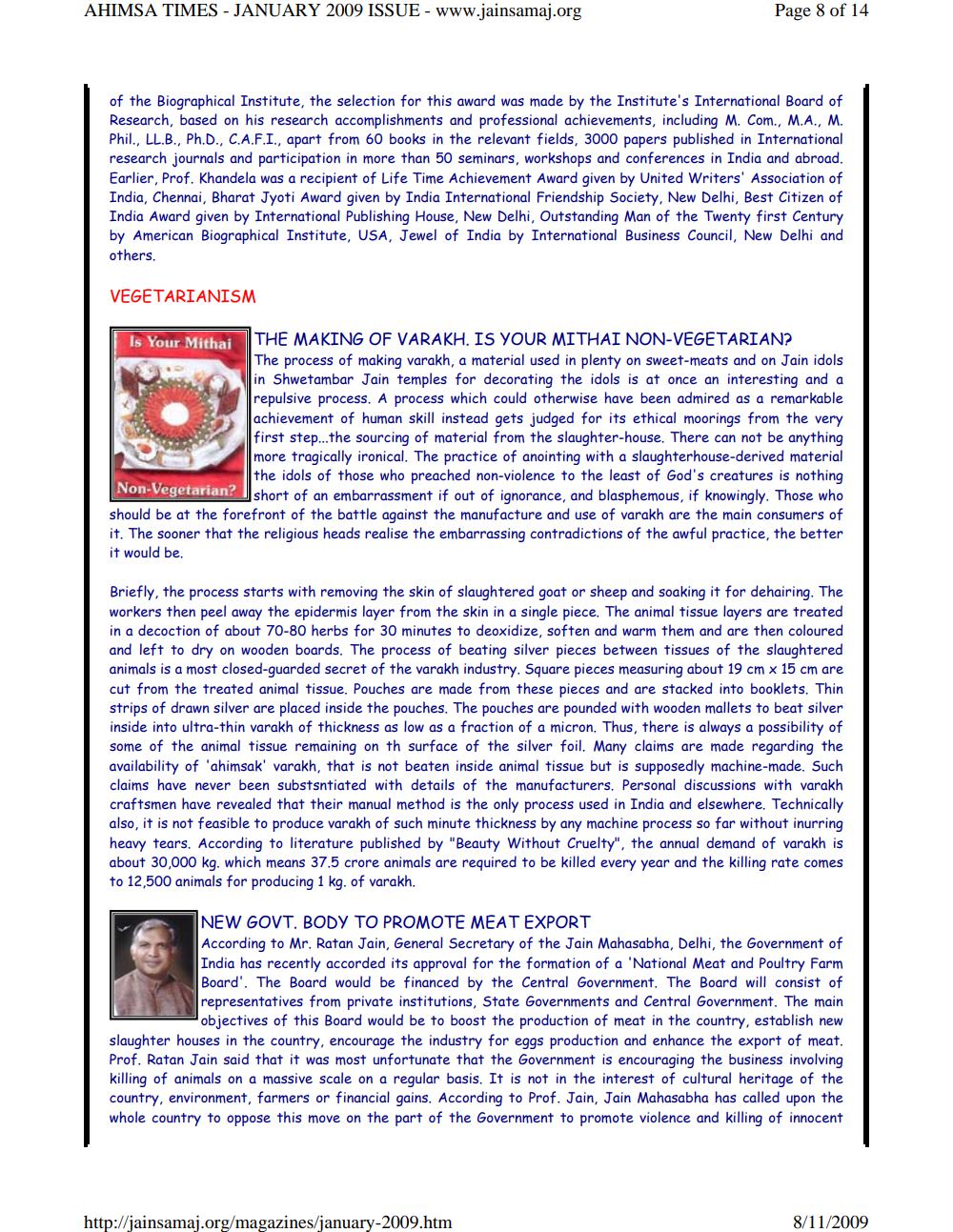Book Title: Ahimsa Times 2009 01 SrNo 103 Author(s): Ahimsa Times Publisher: Ahimsa Times View full book textPage 8
________________ AHIMSA TIMES - JANUARY 2009 ISSUE - www.jainsamaj.org Page 8 of 14 of the Biographical Institute, the selection for this award was made by the Institute's International Board of Research, based on his research accomplishments and professional achievements, including M. Com., M.A., M. Phil., LL.B., Ph.D., C.A.F.I., apart from 60 books in the relevant fields, 3000 papers published in International research journals and participation in more than 50 seminars, workshops and conferences in India and abroad. Earlier, Prof. Khandela was a recipient of Life Time Achievement Award given by United Writers' Association of India, Chennai, Bharat Jyoti Award given by India International Friendship Society, New Delhi, Best Citizen of India Award given by International Publishing House, New Delhi, Outstanding Man of the Twenty first Century by American Biographical Institute, USA, Jewel of India by International Business Council, New Delhi and others. VEGETARIANISM Is Your Mithai THE MAKING OF VARAKH. IS YOUR MITHAI NON-VEGETARIAN? The process of making varakh, a material used in plenty on sweet-meats and on Jain idols in Shwetambar Jain temples for decorating the idols is at once an interesting and a repulsive process. A process which could otherwise have been admired as a remarkable achievement of human skill instead gets judged for its ethical moorings from the very first step... the sourcing of material from the slaughter-house. There can not be anything more tragically ironical. The practice of anointing with a slaughterhouse-derived material the idols of those who preached non-violence to the least of God's creatures is nothing Non-Vegetarian? short of an embarrassment if out of ignorance, and blasphemous, if knowingly. Those who should be at the forefront of the battle against the manufacture and use of varakh are the main consumers of it. The sooner that the religious heads realise the embarrassing contradictions of the awful practice, the better it would be. Briefly, the process starts with removing the skin of slaughtered goat or sheep and soaking it for dehairing. The workers then peel away the epidermis layer from the skin in a single piece. The animal tissue layers are treated in a decoction of about 70-80 herbs for 30 minutes to deoxidize, soften and warm them and are then coloured and left to dry on wooden boards. The process of beating silver pieces between tissues of the slaughtered animals is a most closed-guarded secret of the varakh industry. Square pieces measuring about 19 cm x 15 cm are cut from the treated animal tissue. Pouches are made from these pieces and are stacked into booklets. Thin strips of drawn silver are placed inside the pouches. The pouches are pounded with wooden mallets to beat silver inside into ultra-thin varakh of thickness as low as a fraction of a micron. Thus, there is always a possibility of some of the animal tissue remaining on th surface of the silver foil. Many claims are made regarding the availability of 'ahimsak' varakh, that is not beaten inside animal tissue but is supposedly machine-made. Such claims have never been substsntiated with details of the manufacturers. Personal discussions with varakh craftsmen have revealed that their manual method is the only process used in India and elsewhere. Technically also, it is not feasible to produce varakh of such minute thickness by any machine process so far without inurring heavy tears. According to literature published by "Beauty Without Cruelty", the annual demand of varakh is about 30,000 kg. which means 37.5 crore animals are required to be killed every year and the killing rate comes to 12,500 animals for producing 1 kg. of varakh. NEW GOVT. BODY TO PROMOTE MEAT EXPORT According to Mr. Ratan Jain, General Secretary of the Jain Mahasabha, Delhi, the Government of India has recently accorded its approval for the formation of a 'National Meat and Poultry Farm Board'. The Board would be financed by the Central Government. The Board will consist of representatives from private institutions, State Governments and Central Government. The main objectives of this Board would be to boost the production of meat in the country, establish new slaughter houses in the country, encourage the industry for eggs production and enhance the export of meat Prof. Ratan Jain said that it was most unfortunate that the Government is encouraging the business involving killing of animals on a massive scale on a regular basis. It is not in the interest of cultural heritage of the country, environment, farmers or financial gains. According to Prof. Jain, Jain Mahasabha has called upon the whole country to oppose this move on the part of the Government to promote violence and killing of innocent http://jainsamaj.org/magazines/january-2009.htm 8/11/2009Page Navigation
1 ... 6 7 8 9 10 11 12 13 14
